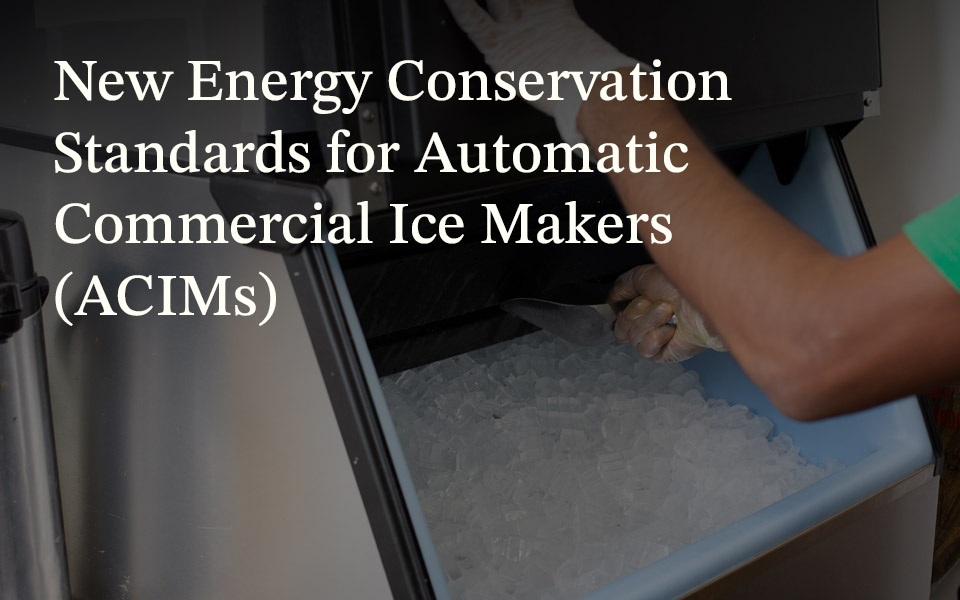The transition to more environmentally friendly refrigerants in commercial refrigeration and air conditioning applications is underway all around the globe. In the United States, ever-evolving state and federal regulations are forcing industry stakeholders to pay close attention to the developments taking place in their regions. Regardless of your specific location or operational requirements, the use of hydrofluorocarbon (HFC) refrigerants is being phased down in favor of alternatives with lower global warming potential (GWP).

I recently co-hosted an E360 Webinar with Jennifer Butsch, Emerson’s regulatory affairs manager of air conditioning, to discuss the latest regulatory developments and industry trends driving this transition. For those who could not attend this informative session, you can view the webinar in its entirety. And if you need a primer for quickly understanding this transition, I developed the following list to highlight the key points of our discussion:
- The refrigerant transition is not new —In the 1980s, scientists discovered that chlorofluorocarbon (CFC) and hydrochlorofluorocarbon (HCFC) refrigerants — such as R-22 — were contributing to the depletion of the ozone layer. The Montreal Protocol Treaty was enacted in 1987 to ban the use of refrigerants with ozone depletion potential (ODP); since then, the hole in the ozone layer has steadily recovered. But the ban on these refrigerants led to the introduction of HFCs — such as R-404A and R-410A — which were then proven to cause global warming. As a result, the Kigali Amendment to the Montreal Protocol was established in 2016 to phase down the use of HFCs; it went into effect in 2019 for its 20 participating member countries.
- The transition is a global effort —Even before the Kigali Amendment went into effect, other global regions and countries established their own HFC phase-down regulations. The European Union’s F-Gas regulations, which went into effect in 2014, has led the way on establishing a framework for rulemaking. Environmental Canada enacted its own HFC rulemaking in 2017; many of its requirements went into effect this year.
- California takes initiative in the U.S. —In the absence of federal regulations, the California Air Resources Board (CARB) has introduced its own HFC phase-down measures, starting with the adoption of the Environmental Protection Agency’s (EPA) Significant New Alternatives Policy (SNAP) Rules 20 and 21. In addition, it is currently working with industry associations and stakeholders to develop proposals to achieve additional GWP reductions by 2030. Many in the industry consider CARB’s proposals among the most ambitious in the world.
- States are joining the charge — Following California’s lead, many states have also committed to introduce climate change initiatives, including the reduction of HFCs. Currently, 25 members have joined the U.S. Climate Alliance, which now represents more than 55% of the U.S. population and an $11.7 trillion economy. A few member states have also adopted SNAP Rules 20 and 21 into law; however, each of these states has set forth varying implementation timelines, which will only add complexity to the national regulatory landscape.
- New federal regulations are on the horizon — To restore federal guidance pertaining to HFC phase-down regulations, both the Senate and the House have recently introduced new bills, respectively: The American Innovation and Manufacturing Act of 2019, and the American Innovation and Manufacturing Leadership Act of 2020. Both bills align with the HFC reduction goals established in the Kigali Amendment and would authorize the EPA to once again regulate HFCs and establish standards for HFC management (servicing, repair, recovery, recycle, reclaim, etc.). The general consensus throughout the industry is that a standardized federal approach would minimize compliance complexities created by a potential patchwork of state regulations.
- The next generation of refrigerants is already here — Many low-GWP alternative refrigerants not only have been developed already, they are being designed to replace HFCs commonly used in specific applications today. These refrigerants offer varying GWP ranges and cover the spectrum of refrigerant safety classifications, from A1 (non-flammable) to A2L (mildly flammable) to A3 (highly flammable) and B2L (toxic, mildly flammable). It’s important to point out that many of the lowest-GWP alternatives are classified as A2L, and thus will require equipment and facility redesigns to meet application and safety standards.
- Safety standards and codes are evolving —With the industry moving toward the use of flammable refrigerants, the technical committees and governing bodies who provide guidelines on how to safely use these refrigerants are actively updating safety standards. While these activities are ongoing, it’s important to remember that once established, these standards will take several years to make their way into both model and local codes needed to permit the widespread use of flammable refrigerants. The industry still has more work to do before that becomes a reality.
- System architectures are changing —This transition is ushering in a new era of system architectures. To utilize low-GWP refrigerants, reduce refrigerant charges and the potential for leaks, look for the commercial refrigeration industry to shift from traditional centralized systems toward more distributed approaches. Natural refrigerant architectures — such as CO2 transcritical booster and R-290 integrated cases — will also continue to expand. Manufacturers are utilizing familiar booster technologies and components to help end users transition to lower-GWP A1s today and even lower-GWP A2Ls in the future. In trials, these systems have provided significant energy savings with reduced installation costs and refrigerant charges.
To learn more details about any of these points, please view this informative webinar in its entirety.

Refrigerant Transition Highlights the Importance of Leak Detection
Although detecting and minimizing leaks in commercial refrigeration equipment have always been...

Let the Refrigerant Phase-in Begin
Evaluating next-generation commercial refrigerant alternatives in established and emerging...

Reviewing Proposed Energy Efficiency Standards for Ice Machines
Earlier this year, the Department of Energy (DOE) published a notice of proposed rulemaking (NOPR)...
